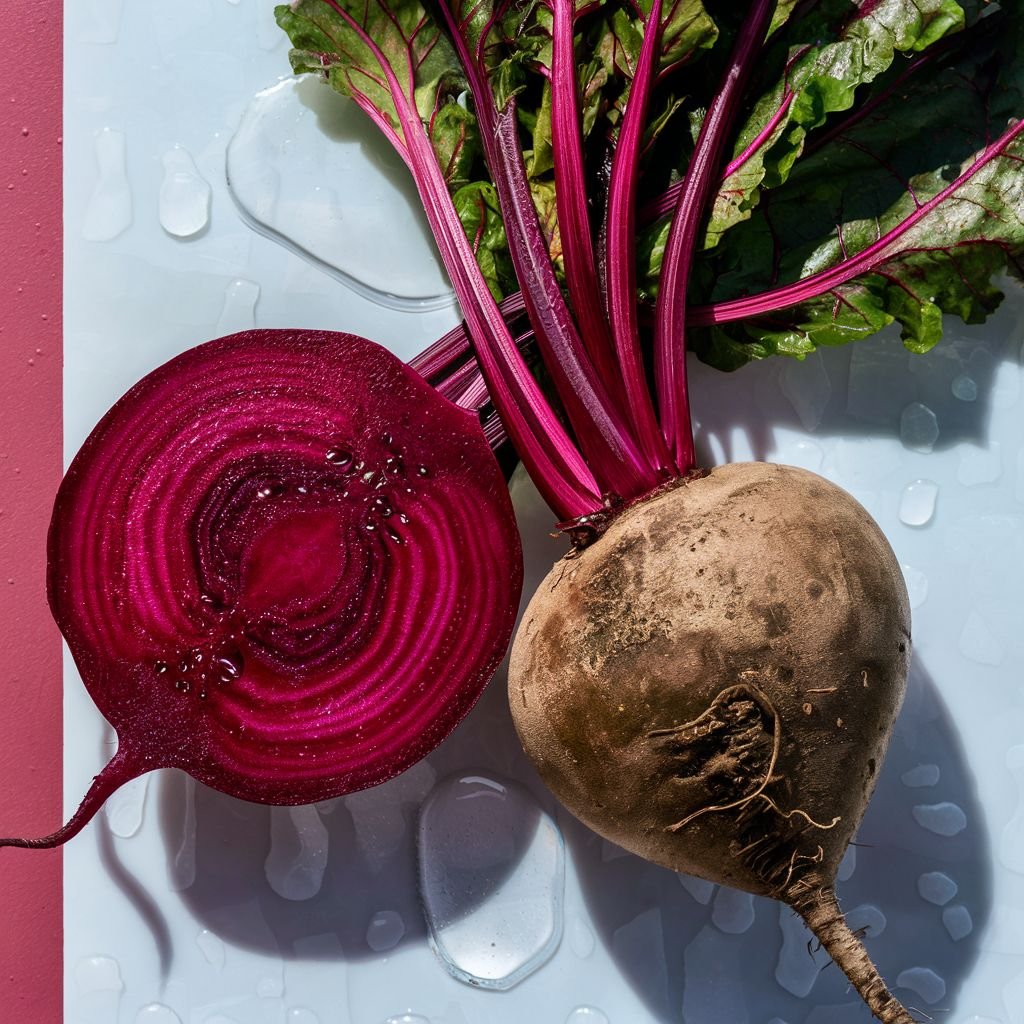Is beet allergy or beetroot allergy real? It definitely is! Read on to find out more.
With their rich, earthy flavor and vibrant red hue, beets are a staple in kitchens worldwide. Not only are they loved for their ability to elevate dishes with both color and taste, but they’re also enjoyed for their impressive nutritional profile, packed with vitamins, minerals, and antioxidants. Whether roasted, pickled, or juiced, beets have carved out their place in many culinary traditions, offering both health benefits and a burst of color on the plate.
Despite these positive attributes, a lesser-known aspect of beets can pose challenges for certain individuals: beet and beetroot allergies. While food allergies are commonly associated with more prevalent allergens like nuts, dairy, and shellfish, allergies to vegetables like beets are less common but equally impactful on the lives of those affected. Recognizing and managing a beet allergy is crucial, as it affects dietary choices and can influence overall well-being.

This article discusses beet and beetroot allergies, from identifying symptoms to understanding risk factors and management strategies. Our goal is to provide a comprehensive guide for anyone looking to navigate life with a beet allergy. Whether you’re seeking to understand this condition better or suspect you might be allergic to beets, you’ll find valuable tips and practical advice to help manage this dietary challenge.
Identifying Beet and Beetroot Allergy
Understanding beet and beetroot allergy starts with recognizing what a food allergy entails. It’s an immune system reaction that occurs soon after eating a certain food, even a small amount. Unfortunately, for some, beets—the vibrant, earthy root vegetables adored by many for their richness in nutrients—can trigger such a response.
Beet Allergy Symptoms
The symptoms of a beet allergy can align with those typical of other food allergies and might range from mild to severe, including:
- Skin Reactions: Hives, itching, or eczema can appear, often one of the first signs of a food allergy.
- Gastrointestinal Symptoms: These can include nausea, stomach pain, vomiting, or diarrhea as the body attempts to rid itself of the offending food.
- Respiratory Problems: Symptoms might encompass coughing, wheezing, a runny or blocked nose, and difficulty breathing, particularly if the allergic reaction is affecting the respiratory system.
- Anaphylaxis: In severe cases, beet allergies can lead to this life-threatening reaction characterized by a swollen throat, a sudden drop in blood pressure, severe shortness of breath, and potential loss of consciousness.
It’s imperative to note that allergic reactions to beets are relatively rare compared to other food allergies. However, the reactions can be significant for those affected and require prompt attention.
Differentiating Allergy from Intolerance
When discussing beet allergies, it’s crucial to distinguish between a true allergy and food intolerance. Unlike an allergic reaction that involves the immune system, food intolerance generally stems from the digestive system’s inability to process certain ingredients properly. While beet intolerance might lead to gastrointestinal discomfort, it doesn’t trigger the immune response seen in allergies.
Understanding the Rarity
Beet allergies are considered uncommon, and because of this, there might be less awareness or information readily available. This rarity also means that reactions to more common allergens, like peanuts or shellfish, are not as well-studied or documented. Therefore, individuals who suspect they have a beet allergy might find it challenging to get a diagnosis or find ample resources on managing this specific allergy.
In this context, knowing the signs and symptoms of beet allergy is crucial for early recognition and management. Whether navigating this condition yourself or supporting someone who is, understanding these allergic reactions forms the foundation for seeking appropriate care and making informed dietary choices.
Causes and Risk Factors of Beet and Beetroot Allergy
Like other food allergies, allergic reactions to beets occur when the immune system erroneously identifies certain proteins found in beets as harmful, leading to an overreactive response. The specifics of why this misidentification happens in some individuals and not others can be traced to various causes and risk factors.
Genetic Predisposition
A key factor in the development of any food allergy is genetics. Suppose immediate family members suffer from allergies—whether food-related or other types like hay fever or asthma—the likelihood of developing similar allergic conditions increases. This genetic predisposition suggests that some individuals are inherently more susceptible to having an overactive immune response to otherwise harmless substances, including specific foods like beets.
Environmental Influences
The environment in which one grows up and lives can also significantly influence the development of allergies. Excessive cleanliness and reduced exposure to various microorganisms in childhood have been theorized under the “hygiene hypothesis” to potentially contribute to an increased risk of allergies, as the immune system may not develop tolerance effectively. Conversely, certain environmental exposures can sensitize individuals to specific allergens.
Cross-Reactivity
A phenomenon known as oral allergy syndrome (OAS) or pollen-food syndrome exists for those already allergic to certain pollens. This condition can lead to cross-reactivity between pollen and related food proteins. For instance, an individual allergic to mugwort pollen might experience allergic reactions to beets due to the similarity in protein structures, triggering an immune response when consuming beet or beetroot.
Age and Exposure
The age at first exposure to certain foods can influence the risk of developing an allergy. Early introduction of a diverse range of foods during infancy has been suggested to help build tolerance. However, the relationship between the timing of exposure and allergy development is complex and varies between individuals.
Identifying At-Risk Individuals
Understanding these risk factors is crucial in identifying those at an increased risk of developing a beet allergy. Individuals with a family history of allergies, existing allergic conditions, or known cross-reactivities should be particularly mindful of potential allergic reactions to beets and beetroot. Recognizing these predispositions allows for earlier symptom monitoring, diagnosis, and management.
The first step toward effective management and prevention is to recognize the underlying causes and risk factors for beet and beetroot allergy.
Diagnosis and Testing for Beet and Beetroot Allergy
Like other food allergies, diagnosing a beet and beetroot allergy involves a combination of clinical evaluation, detailed patient history, and specific allergy testing. Given the relative rarity of beet allergies, the diagnostic process is critical for distinguishing them from other food intolerances or allergic reactions.
Clinical Evaluation and Patient History
The journey towards a diagnosis starts with a thorough clinical evaluation. Healthcare providers will comprehensively review the patient’s medical history, including any family history of allergies, and discuss the symptoms experienced. Key aspects include:
- The nature and timing of symptoms following beet consumption.
- Any previous history of allergic reactions.
- Dietary habits and any recent changes related to the onset of symptoms.
This initial step helps to form a preliminary understanding of whether the symptoms could be related to a beet allergy or another condition.
Allergy Testing
Following the clinical evaluation, specific tests may be recommended to confirm the allergy:
- Skin Prick Test (SPT): A small amount of a diluted allergen, in this case, beet extract, is placed on the skin, typically on the forearm or back. The skin is then lightly pricked to allow the allergen to enter below the surface. If a raised, itchy bump (wheal) surrounded by a red area (flare) appears within 15 to 20 minutes, it indicates a positive reaction and a likely allergy to the substance tested.
- Specific IgE Blood Test: This test measures the level of IgE antibodies to particular allergens present in the blood. A higher concentration of IgE antibodies to beet proteins may indicate an allergy, providing further evidence to support the diagnosis.
- Oral Food Challenge (OFC): Considered the gold standard for diagnosing food allergies, an OFC involves consuming the food suspected of causing the allergy—in this case, beet—under medical supervision. Due to the potential risk of severe allergic reactions, this test is conducted in a controlled setting, typically at an allergy specialist’s office or a hospital.
Challenges in Diagnosing Beet Allergy
Diagnosing beet and beetroot allergy can be challenging due to its rarity, which might lead to less familiarity among some healthcare providers. Moreover, the cross-reactivity with other allergens, such as certain types of pollen, can complicate the diagnostic process. It’s essential for individuals who suspect they have a beet allergy to seek care from an allergist or a healthcare provider experienced in managing food allergies.
Importance of Accurate Diagnosis
An accurate diagnosis is vital for effectively managing a beet allergy. It allows individuals to understand their condition, avoid allergens, and prepare for accidental exposures. Moreover, distinguishing beet allergy from other conditions ensures that unnecessary dietary restrictions are not imposed, preserving nutritional balance and quality of life.

Management and Treatment of Beet and Beetroot Allergy
Once a beet and beetroot allergy diagnosis is confirmed, the focus shifts to effective management and treatment strategies. These aim to prevent exposure, manage accidental ingestions, and ensure individuals can maintain a healthy, balanced lifestyle despite allergies.
Avoidance: Key to Prevention
Avoiding the allergen is the primary strategy for managing a beet and beetroot allergy. This involves several steps:
- Educate Yourself: Learn to recognize all the forms in which beets can appear in foods, including fresh, canned, powdered (as in some food colorings), and as a natural sweetener in processed foods.
- Read Labels Carefully: Always check ingredient lists for beets or beet derivatives on food labels. Be aware that beets might be listed under different names or included in broad categories like “natural flavors.”
- Communicate Dietary Restrictions: When eating out or attending events, clearly communicate your allergy to restaurant staff or hosts to ensure your meals are prepared without beets. Feel free to ask about ingredients and preparation methods.
Managing Accidental Exposures
Despite best efforts, accidental exposures can sometimes occur. Having a plan in place is essential:
- Mild Reactions: Over-the-counter antihistamines may offer relief for minor symptoms, such as itching or a mild rash. However, it’s always best to consult with a healthcare provider for recommendations suited to your specific needs.
- Severe Reactions: In severe reactions, like anaphylaxis, individuals should immediately use an epinephrine auto-injector if prescribed and seek emergency medical attention. Those diagnosed with a beet allergy should always carry an epinephrine auto-injector with them.
Nutritional Considerations
Avoiding beets doesn’t mean missing out on essential nutrients. Beets are known for their high fiber, folate, potassium, and vitamin C content. Individuals avoiding beets can find these nutrients in other foods:
- Fiber: Fruits, vegetables, whole grains, and legumes are excellent fiber sources.
- Folate: Leafy green vegetables, legumes, seeds, and fortified foods can provide folate.
- Potassium: Bananas, oranges, potatoes, and spinach are rich in potassium.
- Vitamin C: Citrus fruits, strawberries, bell peppers, and broccoli offer high levels of vitamin C.
Regular Follow-Up with Healthcare Providers
Ongoing care and regular follow-ups with an allergist or healthcare provider are crucial. These appointments provide opportunities to discuss any changes in the allergy status, adjust management strategies, and address any concerns.
Living with a Beet and Beetroot Allergy: Practical Advice and Coping Strategies
Navigating daily life with a beet and beetroot allergy involves more than just managing dietary restrictions—it’s about adapting to ensure safety while enjoying a rich and fulfilling lifestyle. Here are some practical tips and strategies to help individuals with this allergy live well.
In the Kitchen: Safe Cooking and Eating
- Create a Beet-Free Zone: Make your kitchen safe by eliminating beet and beetroot products. This includes checking condiments and packaged foods, where beet might be used for coloring or flavoring.
- Experiment with Alternatives: Explore alternative ingredients with similar nutritional benefits and flavors. For example, use carrots or raspberries in recipes for natural sweetness and color.
- Educate Family Members: If you live with others, educate them about your allergy to ensure they understand the importance of avoiding cross-contamination when preparing meals.
Dining Out and Social Events
- Research Ahead: When planning to eat out, research restaurants in advance to find those that can accommodate your dietary needs. Many establishments are willing to modify dishes to meet allergy requirements.
- Be Vocal About Your Allergy: Clearly communicate your allergy to restaurant staff. Feel free to ask detailed questions about menu items to ensure they are safe for you to eat.
- Bring Safe Snacks: When attending social events where food will be served, consider bringing your own snacks or a dish to share. This way, you’ll have a safe option if suitable alternatives are unavailable.
Traveling with a Beet Allergy
- Pack Essentials: Always carry safe snacks and an emergency allergy kit, including antihistamines and an epinephrine auto-injector if prescribed.
- Inform Travel Providers: In advance, notify airlines, hotels, and tour operators of your allergy. Many are equipped to accommodate guests with special dietary needs.
- Learn Key Phrases: If traveling abroad, learn to say “I am allergic to beet” in the local language or carry a card explaining your allergy to the country you are visiting.
Building Support and Awareness
- Connect with Others: Join online forums or local support groups for individuals with food allergies. Sharing experiences and tips can be incredibly supportive.
- Educate Your Circle: Help friends, family, and colleagues understand your allergy by explaining the potential risks and how they can support you.
- Advocate for Change: Participate in initiatives to increase awareness and improve labeling standards for allergens in foods. Your voice can help make a difference for those living with food allergies.
Living with a beet and beetroot allergy certainly requires adjustments, but it doesn’t have to diminish your enjoyment of food or limit your activities. With the right precautions and a positive attitude, you can navigate challenges successfully and lead a healthy, active life. Embracing creativity in the kitchen, advocating for your health needs, and building a supportive community are all key components of thriving despite dietary restrictions.
Beet Allergy and Oxalates
Living with a beet and beetroot allergy involves managing direct exposure to beets and being aware of other considerations that may impact health and well-being. For instance, the oxalate content in beets and potential hidden sources of exposure are important factors to consider.
Oxalates and Health
- Oxalates in Beets: Beets, like rhubarbs, also contain oxalates, natural compounds that can bind with calcium in the body, potentially leading to kidney stones in susceptible individuals. While not directly related to allergic reactions, those with a history of kidney stones or who are advised to follow a low-oxalate diet may need to be cautious with beet consumption.
- Balancing Nutrition: If you’re avoiding beets due to allergy and are concerned about oxalate intake, ensure you’re receiving a balanced intake of nutrients from other sources. A registered dietitian can help tailor a diet plan that meets your nutritional needs while considering these restrictions.
Hidden Sources of Beet Exposure
- Food Coloring: Natural red food coloring derived from beets, labeled as E162 or beetroot red, is used in various products, from candies to beverages. Being aware of this can help avoid unintentional exposure.
- Supplements and Health Products: Certain health supplements may contain beetroot powder, including those for liver support or athletic performance. Always check labels and consult with healthcare providers before adding new supplements.
Navigating Challenges with Awareness
Understanding these additional considerations surrounding beet and beetroot allergy ensures a more comprehensive approach to managing the allergy. Being informed allows for better decision-making regarding diet and health, ensuring you stay well while navigating the challenges of a beet allergy.
Conclusion
Navigating life with a beet and beetroot allergy, while certainly requiring mindfulness and adjustments, doesn’t have to be daunting. This comprehensive guide has walked you through understanding what beets are, identifying and diagnosing an allergy, and managing and living with this condition. We’ve covered practical advice for everyday living, from cooking and dining out to traveling and building a supportive network.
Living with a beet allergy underscores the importance of awareness, communication, and advocacy. Educating yourself and those around you can minimize risks and manage your allergy effectively. Remember, the goal is to avoid allergic reactions and enjoy a healthy, allergyfree lifestyle despite dietary restrictions.



